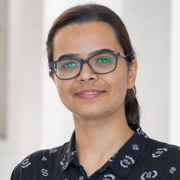
Dr. Jasleen Kaur Lall
Faculty of Engineering | Department of Microsystems Engineering
University of Freiburg
Projects
Autonomous light-actuated LCE actuators
Project description
Liquid crystal elastomers (LCEs) are an interesting material for generating three-dimensional actuators, which can be triggered by light in a wavelength-selective manner. In collaboration with a chemist, I will fabricate the LCE actuator with the standard processes of microsystem technology. The aim is to create photo-actuated devices for integrated, miniaturized systems. We want to develop demonstrators, such as a tunable aperture system that automatically adjusts to the brightness of light, similar to how the mammalian iris functions.
Supervisor and dissertation
Prof. Dr. Hans Zappe
Jasleen Kaur Lall completed her dissertation in November 2023.
Dissertation: Light-responsive liquid crystalline actuators for microsystems: from molecule to device
Moved on to
Jasleen began a position as an applications engineer at Mechaless Systems GmbH
Publications in livMatS
- MEMS-compatible structuring of liquid crystal network actuators using maskless photolithography*
Lall, J., & Zappe, H. (2022). MEMS-compatible structuring of liquid crystal network actuators using maskless photolithography. Smart Materials and Structures, 31(11), 115014. doi: 10.1088/1361-665X/ac95e5 - In situ, spatially variable photoalignment of liquid crystals inside a glass cell using brilliant yellow
Lall, J., & Zappe, H. (2022, May). In situ, spatially variable photoalignment of liquid crystals inside a glass cell using brilliant yellow. In Photosensitive Materials and their Applications II (Vol. 12151, pp. 91-97). SPIE. doi: 10.1117/12.2621178 - Structuring of liquid crystal elastomer actuators with selective polymerization for MEMS devices
Lall, J., & Zappe, H. (2022, March). Structuring of liquid crystal elastomer actuators with selective polymerization for MEMS devices. In Advanced Fabrication Technologies for Micro/Nano Optics and Photonics XV (Vol. 12012, pp. 30-37). SPIE. doi: 10.1117/12.2608696
* Funded by the Deutsche Forschungsgemeinschaft (DFG, German Research Foundation) under Germany's Excellence Strategy – EXC-2193/1 – 390951807